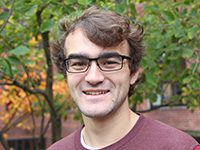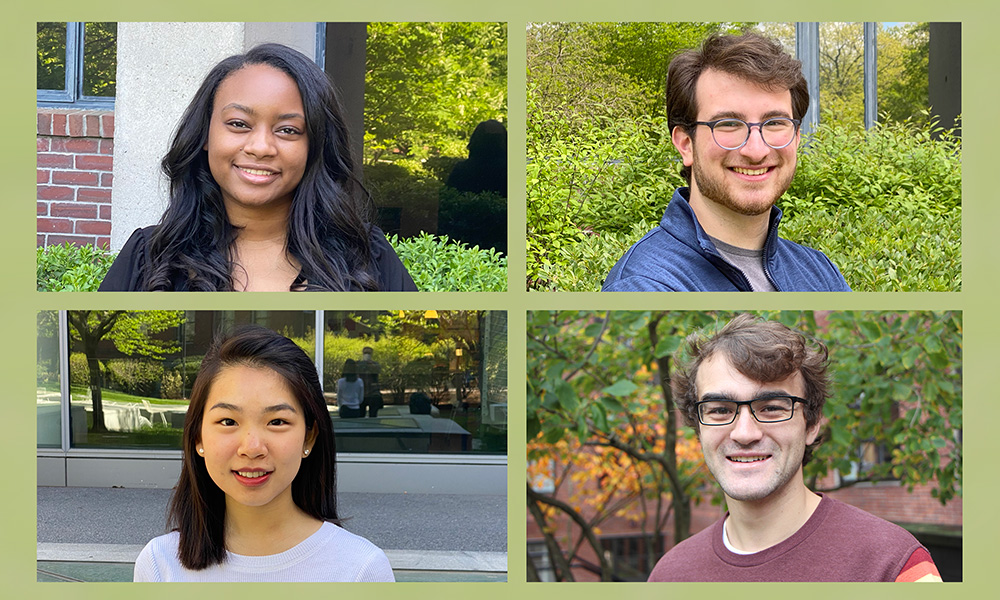Each year, the FAS Prize Office awards the Thomas Henry Hoopes Prize for undergraduate thesis work to a handful of exceptional students. It is one of the highest honors given to undergraduates. This year’s Hoopes recipients include Ashley Cooper (Neuro and Anthropology ‘21), Ralph Estanboulieh (CPB and Computer Science ‘21), Kathleen Ran (Neuro ‘21), and William Stainier (CPB ‘21).
Candidates for the Hoopes Prize are nominated by faculty across the university and chosen based, in part, on readers’ comments on the thesis. Student awardees each receive $5,000, their faculty nominators receive $2,000, and copies of the winning theses are bound and added to the Lamont Library.
Congratulations to these Hoopes Prize Winners!

Ashley Cooper (Neuro and Anthropology ‘21)
“Racism’s Health Harm on Black Youth Mental Health: From (Neuro)Scientific Orthodoxy to Neuroscience as a Vessel of Visibility”
As a joint concentrator in Neuroscience and Anthropology, Ashley Cooper investigated a topic that connects the two fields and has many ramifications for promoting accessibility in mental health care.
One of Cooper’s goals was making the psychological toll of racism more visible. “I hoped to illuminate a gap in neuroscientific literature that has far too often been overlooked: evaluating the deleterious impact of racism as an adverse childhood experience in the lives of Black youth. There is a symbolic violence, a palpable, yet insidious, harm engendered by this gap that desperately needs to be acknowledged,” she says. “I envisioned my thesis as an act of reclamation, love, and care. My goal in life is to liberate Black children from the notion that their mental health does not matter, and this thesis was my first step in doing that.”
“The scope of the project Ms. Cooper undertook was herculean,” says Cooper’s thesis co-advisor and nominator Marisa Silveri of McLean Hospital. “She seamlessly melded anthropology and neuroscience to address mental health disparities that are both unique and profound in black youth. She thoughtfully articulated her aims and applied a neuroscience approach, grounded in historical understanding, to examine and link neurobiology with race, perceived discrimination and depressive symptoms in black youth. She accomplished her goals with substantial aplomb.”
Medical Anthropology professor Byron Good also advised Cooper’s thesis and was likewise impressed by the scope of the project. “This project grows out of a deep commitment of Ms. Cooper’s, from the time I met her as a sophomore, to understand why rates of suicide and suicide attempts among African American youth aged 5 to 13 are twice those of white youth in the United States. The thesis shows that while there is a general acceptance that racism must surely have an effect on mental health of African American youth, there has long been resistance to fund and carry out research—both in the social sciences and in neurodevelopmental sciences—that demonstrates precisely how experiences of racism affect neurodevelopment and risk for mental health problems.”
He adds, “Ashley not only conducted original historical research, interviewing researchers and policy makers, but conducted an analysis of a large, existing data base to demonstrate the feasibility of linking levels of experience of racial discrimination to specific aspects of neurodevelopment.”
Cooper’s thesis also earned the Anthropology Department’s Clyde Kluckhohn Award, which also recognizes outstanding undergraduate research.
Cooper says that her interdisciplinary education was invaluable for tackling the thesis topic. “I think being able to do a joint concentration in Neuroscience and Social Anthropology, two seemingly disparate fields, has really shaped me to view challenges from a more creative lens,” Cooper says. “My joint also radically transformed my thinking about the bounds of academic work—I think there is an urgency to conducting interdisciplinary and cross-disciplinary work. I think such work harnesses revolutionary potential as it has the capacity to reshape the very confines of what is, and what is not, considered knowledge.”
“I encourage anyone who is interested in a joint concentration to pursue it—no matter how bizarre it might initially appear or feel,” she adds.
For Cooper, 2020 was an exceptionally difficult year. She dedicated her thesis in loving memory of her mother, who passed away after a long battle with cancer. In her dedication, Cooper wrote of both her mother and her late father, writing: “You have instilled in me that all things in life worth doing, begin—and end—as acts of love. I envisioned this thesis as a work of love—my hope is that the souls of my parents shine through in its inscription.”
“This year has by far been the most difficult one of my entire life. I have experienced a great deal of loss and constant change,” Cooper adds. “That is why the support and encouragement I have received this past year has felt all the more meaningful to me.”
Cooper expressed gratitude to many mentors and supporters. “I am incredibly thankful to my parents, Dr. Silveri, Dr. Good, the entire Silveri Lab, the Neuro and Anthro departments, and the Mellon Mays Undergraduate Fellowship for developing my research interests and informing who I am today,” she says. “My experiences as an undergraduate have reshaped what I believe to be possible and have brought me one step closer to the work I hope to ultimately do throughout my life. It has been a lesson in how to effect sustainable and long-lasting change. And to my loving friends and family, I could never thank you enough for your invariable care and support. Without you all, this would not be possible—I am immensely grateful!”

Ralph Estanboulieh (CPB and Computer Science ‘21)
“Deep Learning Models for Variant Pathogenicity Prediction”
CPB concentrator Ralph Estanboulieh is interested in combining biology and computer science to understand the complex networks of interacting molecules that make up living cells. “I chose my thesis topic because it allowed me to develop a computational approach to better solve a problem that lies in the intersection between biology and computation: predicting disease based on genome sequencing data and the molecular interactions between genes and proteins,” Estanboulieh says. “More broadly, I want to work on methods to better understand the ‘interactome‘ — the gigantic map of molecular interactions between genes and proteins.”
Existing computational biology techniques ignore wide swaths of the interactome, so Estanboulieh decided to work on algorithms that predict pathogenicity and incorporate interactome knowledge. “Many statistical learning algorithms have been developed to predict the disease-causality of genetic mutations, all of which ignore the complex web of gene and protein interactions,” he says. “Because of these interactions, the consequence of several variants spanning different genes is no longer a straightforward calculation.”
“The purpose of my thesis is to redefine pathogenicity as a property of a network of variants rather than of a single variant,” he adds.“To do so, I reviewed common pathogenicity prediction algorithms, reproduced and analyzed a well-known prediction method, and proposed deep learning architectures and training schemes that address the most salient challenges facing pathogenicity prediction, including the integration of gene and protein interactions.”
The work impressed Estanboulieh’s thesis adviser and nominator Arjun Manrai of the Computational Health Informatics Program (CHIP) at Boston Children’s Hospital. “Ralph’s thesis first presents a brilliant and unifying synthesis of several decades of foundational work on the classification of genetic variants and then builds upon this foundation to propose a series of new deep learning models to improve variant classification,” Manrai says. “The Hoopes Prize is a wonderful recognition of outstanding scholarship. I believe Ralph being chosen as a recipient is a testament to his exceptional creativity and to his ability to see deep connections between the fields of computer science and biology.”
Estanboulieh is thrilled to receive the Hoopes Prize. “I grew up in a place devoid of resources, opportunities, and sometimes even hope, and the resulting hurdles have made the playing field very uneven,” Estanboulieh says. “Nevertheless, I am extremely lucky to say that I have been able to run across that uneven field. I am lucky because I work with a caring advisor, Dr. Manrai, on a problem that aligns so well with my broader academic interests. I am lucky because I have been surrounded by compassionate friends, professors, and mentors. And I know the best way to express my gratitude to them is to, just like them, be for others a source of luck and a compassionate friend, mentor — and maybe professor, if things go according to plan. This part is very, very important!”

Kathleen Ran (Neuro ‘21)
“Identifying novel AD-risk genes implicated in microglia engulfment function using iPSC-derived Microglia (iMGLs)”
Neuroscience concentrator Kathleen Ran’s thesis research investigated the currently intractable problem of Alzheimer’s and the role of non-neuronal brain cells called microglia, which provide an immune defense for the central nervous system.”Microglia are a hot topic in Alzheimer’s disease research, and I was excited to be a part of this broader scientific effort,” Ran says.
Specifically, her experiments focused on cellular behavior called engulfment, where the microglia swallow up dying neurons before harmful debris from the disintegrating cell can damage other nearby neurons. Microglia’s ability to engulf is important for keeping damage to neurons contained, and previous studies have indicated that it may be disrupted in Alzheimer’s.
“In the first part of my project, I measured gene expression levels in microglia by analyzing single-cell RNA sequencing data,” Ran says. “I then knocked out genes associated with Alzheimer’s risk in microglia using CRISPR-Cas9. By measuring engulfment activity following genetic knockout, I determined the direct effect of these genes on microglia engulfment function. My results suggest that modulating microglia engulfment activity is potentially a key mechanism by which genes confer Alzheimer’s disease risk.”
“Kathleen’s thesis is a beautiful example of how new technologies can inform biological processes and it truly showcased her creative thinking and excellent scientific skills,” says Ran’s thesis adviser and nominator Beth Stevens of the Stanley Center at the Broad Institute. “Kathleen is a quick learner and adapts quickly, always keeping her project moving forward despite COVID associated challenges, while developing her bioinformatic and wet lab skills. She is very independent and resourceful and able to problem solve and overcome challenges…I can’t wait to see what she will do next!”
Ran’s work on her thesis also earned her the Dowling Prize for undergraduate research in neurobiology.
“I am overwhelmed with gratitude for the numerous individuals who supported me throughout my senior thesis project. Professor Beth Stevens and Dr. Martine Therrien taught me so much about a very new and niche area of neuroscience,” Ran says. “From this experience and their mentorship, I have learned how to creatively and methodically tackle challenging scientific questions. I am also lucky to have friends and family who have cheered me on before, during, and after my thesis project.”

William Stainier (CPB ‘21)
“The Natural Viral Environment of Caenorhabditis elegans: Interactions between RNA Interference, the Dauer State, and Orsay Virus Infection”
For his thesis, CPB concentrator Will Stainier looked into how the model organism C.elegans uses RNA interference (RNAi) to fend off viral infections.
“Host-virus relationships are a prominent part of an organism’s interactions with its surroundings,” Stainier explains. “I was particularly motivated by my topic because it allowed me to further investigate the intricacies of RNAi in C. elegans–something which I had been doing since I started working in the Hunter lab–and also explore virology.”
In antiviral RNAi, a few of cell’s non-coding RNAs bind to invading viral RNAs, thus preventing the transcription of the viral RNA. RNAi is a common cellular defense against pathogens as well a mechanism to modulate gene expression. Stainier wanted to find out how C. elegans use RNAi to prevent the spread of Orsay virus through worm populations. He also investigated Orsay virus infection during a larval phase of C. elegans development called the Dauer State.
“I made sure to use the model organism’s unique advantages–particularly the ease with which one can culture large numbers of worms–to investigate viral infection on both an individual worm level as well as on a population scale,” Stainier says. “Despite a reported role for the RNAi machinery at some point during the viral infection, my data surprisingly suggest that it does not protect worms during the initial phase of infection.”
MCB faculty and Stainier’s thesis adviser Craig Hunter says that everyone in his lab was thrilled when Stainier won the Hoopes. “William has been part of our lab for nearly four years, and we were so excited for his research that he received [the] highest priority to return to the lab during the pandemic,” Hunter says. “What I really liked about his thesis is that each of his results proved each of our preconceived notions wrong. The Hoopes prize is a testament to his experimental design, rigorous data collection, beautiful documentation, and clear prose.”
The Board of Tutors in Biochemical Sciences also took notice of Stainier’s thorough work and awarded his thesis the Henderson Prize, which recognizes outstanding undergraduate thesis work in biochemistry.
Stainier is deeply appreciative of the support from the Hunter Lab and the broader community, saying, “It’s a great honor to have received the Hoopes Prize, and it wouldn’t have been possible without the help of Prof. Craig Hunter and the rest of his lab.”


